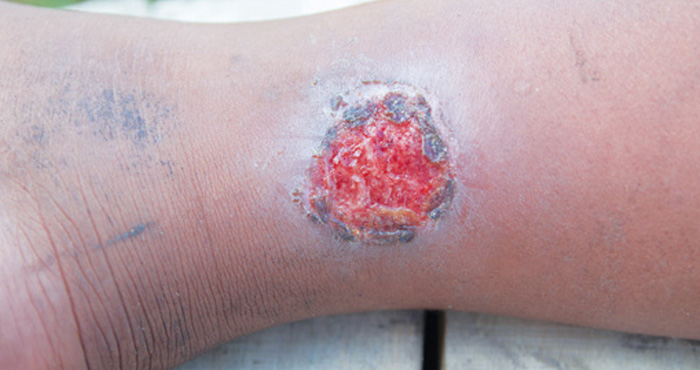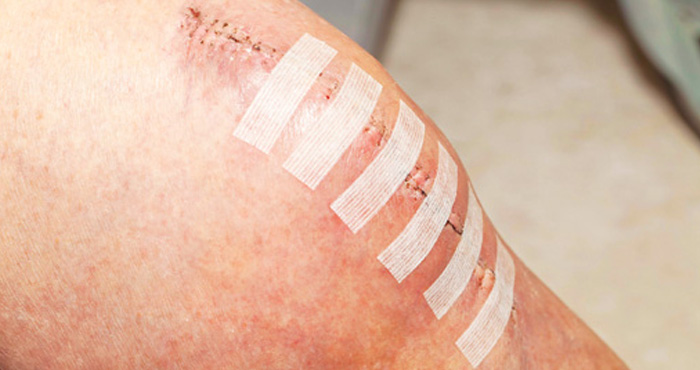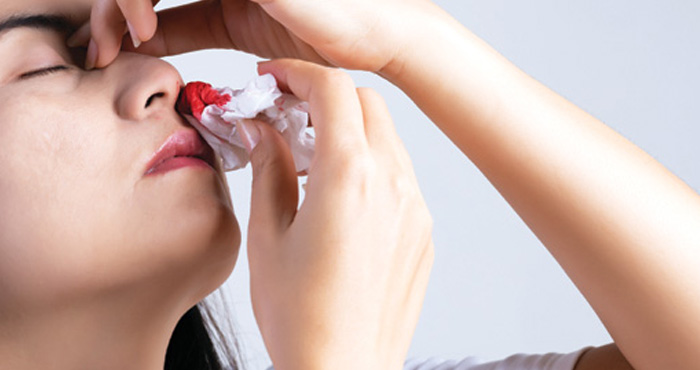Venous leg ulcers: A silent crisis?
In Clinical
Follow this topic
Bookmark
Record learning outcomes
Described as ‘a silent crisis’ in a recent report published by the All-Party Parliamentary Group on Vascular and Venous Disease (VVAPPG), venous leg ulcers impose a heavy burden on both sufferers and the healthcare system as a whole

Learning objectives
After reading this feature you should be able to:
- Explain the key causes and risk factors for venous leg ulcers
- Support patients to help optimise healing and prevent recurrence
- Provide practical advice on treating and managing minor injuries, wounds and scars.
Current figures suggest that over 200,000 people in the UK suffer from venous leg ulcers – and this may even underestimate the true scale of the problem as many patients remain undiagnosed.2 Venous leg ulcers are a major cause of morbidity and place a heavy burden on the NHS, with current spending on management estimated to top £1 billion per year.2 The vast majority of this cost is swallowed up by community nurse visits, as well as outlay for dressings, compression bandages and other treatment modalities.2
From a patient perspective, venous leg ulcers are associated with significant pain, distress, social isolation and loss of independence, which all combine to negatively impact on overall quality of life. As Derek Thomas, MP and chair of the All-Party Parliamentary Group on Vascular and Venous Disease in the last Parliament, explained: “Pressure sores, wounds and ulcers of all types carry a heavy burden on the health and wellbeing of people across the country. They force people to learn to live with chronic pain and disrupt their lives signiï¬cantly – taking a heavy toll on their mental health.”2
Venous disease, which is typified by sluggish blood flow from the legs to the heart, is responsible for around 70 per cent of all chronic leg wounds.2 In patients with venous leg ulcers, the primary culprit is faulty valves in the legs that allow blood to flow backwards or ‘reflux’ down the legs. This causes a build-up of persistent high pressure in the leg veins, which damages tiny blood vessels in the surrounding skin. The skin in turn becomes dry, itchy and inflamed, vulnerable to any small break or scratch, which can lead to an open wound with minimal trauma.
Venous leg ulcers are typically tenacious – characterised by failure to heal and high rates of recurrence. This failure of venous leg ulcers to heal properly is compounded by the poor blood supply to the affected area. Recurrence is also common because, in most cases, the problem with the underlying veins remains.
“Management of wounds requires constant attention to support healing and avoid reoccurrence,” says Derek Thomas. “If the NHS is to reduce the burden of wounds, the system needs to focus on their cause and treat that effectively.”2 This is particularly vital given that the costs associated with managing an active venous leg ulcer are nearly five times higher than those of caring for a healed wound.2
Managing wounds requires constant attention to support healing and avoid reoccurrence
Optimal healing
The vast majority of venous leg ulcers are currently managed in primary care. Treatment is centred on the initial cleaning and dressing of the wound followed by ongoing use of compression bandages or stockings to boost blood flow in the legs. Pharmacists can play an important role in management by helping to ensure adherence to treatment – currently one of the main barriers to effective healing.
Venous leg ulcers are painful, malodorous and require constant attention, which can be challenging for sufferers. Changing the dressing can also be a painful experience when the ulcer is exposed to the air. In most cases, a simple non-sticky dressing will be used, which should be changed once a week, usually under the supervision of a nurse.
It is important that patients fully understand their treatment regimen and are supported in sticking to the required dressing changes and recommended compression therapy. Although the initial period of compression over a new ulcer is painful, when used correctly compression bandages and stockings are actually proven to relieve pain in the legs by controlling the build-up of pressure within the veins. Reassure customers that their pain will lessen as the ulcer heals and should start to recede after about 10 days. If the compression feels uncomfortable or overly tight, then a brief walk may help.
Customers prescribed stockings or bandages should be advised to take care when washing them, following the instructions closely to avoid damaging the elastic, and to replace these items every three to six months. Stockings should not be pulled too high up the leg and never turned over at the top as this can further impede blood flow to the leg.
Scar management
Optimal wound management at the time of injury is essential to mitigate and minimise any future scar formation. However, in cases where some degree of scarring cannot be avoided, it is important to provide reassurance that most scars will gradually fade and become less visible over time.
The lynchpins of OTC scar treatment are silicone-based products such as topical silicone gels that are rubbed into the skin (normally twice daily) and silicone gel sheets, which are applied to the scar for up to 12 hours a day. These products act to soften and flatten scar tissue, with the added bonus of relieving associated itching and discomfort.
For optimal results, silicone products should be used for at least three months. Regularly massaging oil or moisturisers into the scar can also help boost skin hydration and soften scar tissue. Effective sun protection is important due to the potential impact of sun exposure on the size and appearance of the scar tissue. Pharmacy staff are well positioned to provide suggestions on skin camouflage, as many leading cosmetic brands are now providing make-up designed for covering facial scars.

Pharmacy teams can also provide advice on analgesia for pain management (paracetamol is preferred first-line) and emollient use to help keep the surrounding skin moisturised.3 Antibiotics may be prescribed for ulcers which become infected, signs of which include increasing pain, discharge and redness.
As with any chronic condition, self-management strategies are an important tenet of care for venous leg ulcers. According to the British Association of Dermatologists (BAD) key self-care advice should include:4
- Elevate legs when sitting and avoid long periods of standing
- Take regular exercise such as walking or practise regular foot raises (for the less mobile)
- Regularly moisturise the skin surrounding the ulcer.
General healthy living advice such as smoking cessation, maintenance of a well-balanced diet to promote skin healing and moderation of alcohol consumption should be provided. Patients can also be signposted to local healthy leg clubs (e.g. the Lindsay Leg Club Foundation) for further advice and support.
Key facts
- In the UK, over 200,000 people are affected by venous leg ulcers
- After cleaning and dressing the wound, compression therapy is the cornerstone of care
- Tackling key risk factors such as obesity and immobility is an important step towards prevention.
It is important that patients are supported in sticking to the required dressing changes and recommended compression therapy
Dealing with minor injuries
At the less severe end of the wound spectrum, products for treating minor injuries are essential elements in any home first aid kit. Make sure your pharmacy teams are clued up
Cuts and grazes
Cuts and grazes can be tackled with simple measures to stop the bleeding and then clean and dress the wound. For a wound that is actively bleeding, pressure should be applied using a clean, dry, absorbent material (e.g. a towel or handkerchief) to stem the flow of blood. Advise customers to raise the affected area above the level of the heart (i.e. for a cut on the hand, raise the arm above the head) until the bleeding stops.
The wound should then be cleaned with tap water and a sterile adhesive dressing applied. A plethora of different plasters and dressings are now available OTC including specialised products that promote a moist wound healing environment, those embedded with antimicrobial ingredients and hypoallergenic formulations for people with sensitivity to plasters. The most important priority is to ensure the wound is covered and the dressing changed on a regular basis, particularly if it becomes dirty or wet.
Minor burns
The first step when faced with a minor burn is to cool immediately under cold running water for 10-20 minutes. This rapid cooling not only reduces pain and swelling but also minimises the risk of scarring. After cooling, the burn should be covered with clingfilm or a clean plastic bag to help prevent infection and further ease pain by keeping air away from the skin’s surface. It is normal for burns to remain painful even after cooling, so appropriate analgesics can be recommended. Ice, butter, creams, toothpaste, plasters or adhesive bandages should never be applied to a burnt area of skin.
Sprains and strains
RICE (rest, ice, compression and elevation) remains the key buzzword when managing sprains and strains. To limit swelling, ice should be applied to the sprain/strain for 20 minutes every two to three hours and an elasticated bandage used to wrap the injured area to provide support, reduce blood flow and ameliorate swelling. Advise customers to keep the affected limb elevated as much as possible. Simple analgesics such as paracetamol and ibuprofen can be recommended for pain management, with topical formulations particularly well-suited to musculoskeletal injuries. Remember that NSAIDs should be avoided in the immediate 48-hour period after injury as they can hamper the healing process.
Nosebleeds
Although nosebleeds can understandably elicit concern among customers, in the vast majority of cases they do not signify a serious or sinister underlying condition and are simply due to minor damage to the delicate blood vessels that line the inside of the nose. To staunch the flow of blood, recommend that the affected individual sits or stands upright and pinches the soft parts of their nose together, just above the nostrils, using the thumb and index finger for 10-15 minutes. Leaning forward slightly is also advisable to prevent blood from running back down into the sinuses and throat.
After the bleeding has eased, an icepack should be applied to the top of the nose. To prevent nosebleeds recurring, customers should be advised to avoid picking or blowing their nose, drinking hot drinks or alcohol, or engaging in intensive physical activity in the 24 hours after suffering a bleed.

Preventing recurrence
As well as helping to support patients with treatment, the pharmacy team has a key role to play in leg ulcer prevention by tackling underlying risk factors and promoting vigilance for early signs and symptoms of new/recurrent venous ulcers.
Swelling and pain in the legs, especially when brought on by prolonged standing, is a key harbinger of potential leg ulcer development.
Other warning flags include the development of brown spots/patches on the skin, areas of skin which appear red or blue in colour due to changes in the underlying blood flow, and itchy/scaly skin on the lower leg with firm or tender areas below it.
As BAD graphically describes: “The ulcer itself is an open wound. The bed of the ulcer may show bumpy, moist and red healing tissue, or may be covered in a yellowish-grey layer. Ulcers often leak fluid, the amount of which can vary.”4
Early identification of venous leg ulcers is important as current NICE guidance demands that any patient with an ulcer which does not heal within two weeks should be referred to a specialist vascular service and undergo a comprehensive vascular assessment.2 However, the VVAPPG report found that up to 75 per cent of patients currently fail to receive this vital assessment and may suffer adverse outcomes due to sub-optimal treatment pathways and misdiagnosis.1
Identifying and addressing the underlying health issues that lead to venous leg ulcers is clearly a critical step towards tackling the problem at its root cause, rather than just managing symptoms. Obesity is a major cause and an increasingly overweight population in the UK is expected to fuel rising cases of venous leg ulcers in the future.
Regular exercise and weight loss advice should therefore be enshrined within pharmacy guidance, both to reduce the risk of venous leg ulcer development in at-risk individuals and to lower the chances of ulcer recurrence in prior sufferers.
Other, albeit less modifiable, risk factors to be aware of include increasing age, previous DVT, reduced mobility due to osteoarthritis or injury, recent leg surgery (such as hip/knee replacement) or varicose veins.
References
- Venous News: Parliamentary group report raises awareness of difficulties with venous leg ulcers
- All-Party Parliamentary Group on Vascular and Venous Disease: Venous Leg Ulcers: A Silent Crisis
- NHS website
- British Association of Dermatologists (BAD): Venous leg ulcers leaflet
